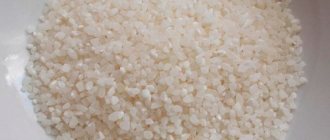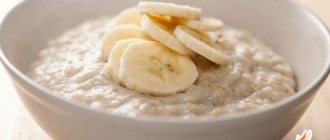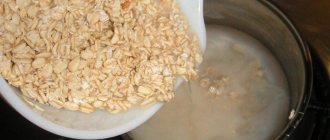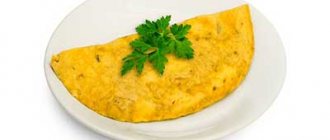About buckwheat
Since ancient times, people began to eat buckwheat. It appeared in Rus' many centuries ago and immediately gained popularity among the inhabitants of that time due to its satiety. It is generally accepted that it got its interesting name from the root of the name of the country of Greece. But many linguists argue with this fact, arguing that in Rus' they began to call it thanks to the word “walnut”, because in one of the localities it was named after the name of the nuts of the same name, or even from the word “warm”, since it was previously burned in ovens for better preservation.
Buckwheat grows, as well as is consumed, in many countries of the world, including Russia. Buckwheat blooms at the end of June, and what wonderful, tasty and healthy honey comes from it!
People use cereals not only for making porridge, but also cutlets, soups, pancakes, and baked goods. It is very filling and, like any cereal, is good for breakfast. The onset of hunger is not felt soon.
The benefits of cereals
Buckwheat is so rich in useful substances and elements that even if you eat exclusively this grain for some time, you are unlikely to cause harm to your body. It contains vitamins B, P, PP, E, C, as well as potassium, calcium, phosphorus, copper, zinc, iodine, boron, cobalt and a large amount of iron.

Eating buckwheat has a good effect on the nervous system, and due to the high fiber content in its composition, it helps people with gastrointestinal problems and heart patients. And, of course, we shouldn’t forget how much help it provides to those losing weight. Buckwheat, with its low calorie content, but at the same time an abundance of useful elements, such as folic acid, helps pregnant women maintain their figure and not gain weight, and also has a beneficial effect on the baby’s nervous system.
Content of useful elements in buckwheat

Table: content of microelements and vitamins per 100 grams of dry buckwheat
| Name | Content | Daily requirement % |
| Co (cobalt) | 3.1 mcg | 0.31 |
| PP (niacin) | 4.19 mg | 17 |
| K (potassium) | 380 mg | 19 |
| Ca (calcium) | 20 mg | 2 |
| Mg (magnesium) | 200 mg | 57 |
| B9 (folic acid) | 32 mcg | 3.2 |
| B1 (thiamine) | 0.43 mg | 29 |
| B6 (pyridoxine) | 0.4 mg | 20 |
| Fe (iron) | 6.6 mg | 44 |
| Cu (copper) | 0.64 mg | 43 |
| B2 (riboflavin) | 0.2 mg | 12 |
Buckwheat also contains manganese, chromium, silicon and zinc.
Calorie content of cereal
Almost no diet is complete without buckwheat. But why did this happen? Let's look at its composition and nutritional value. Boiled cereal without additives contains approximately the following amount of BJU: proteins - 17.5%, fats - 4.5%, carbohydrates - 78%, and about 95-100 kilocalories. Despite the large amount of carbohydrates, cereal is ideal for weight loss, as it contains a lot of useful elements.
However, there are some nuances that are important to know. Thus, nutritionists do not recommend consuming boiled buckwheat, since it loses a sufficient amount of vitamins and minerals. It is recommended to pour the cereal with water, leave it overnight, and in the morning, already steamed, use it for food, preserving in it everything that is beneficial for our health.

There are even strict mono-diets based on the consumption of buckwheat in this form. A considerable number of people have lost weight on such a strict diet, but since it has a peculiar strong taste, porridge quickly gets boring. Many simply cannot stand it and try to turn it into a more tasty dish.
What are the benefits of buckwheat porridge? Composition, calorie content
Buckwheat porridge is familiar to everyone since childhood. Many people cook it in water, some housewives cook it in milk, others like buckwheat with meat or stew.
The benefits of this dish are undeniable: buckwheat contains many vitamins, iron, various acids and mineral elements.
This porridge improves digestion, the appearance of hair and skin, promotes weight loss, and removes toxins from the body. In addition, it is very tasty, nutritious and satisfying.
Characteristics and composition
It is not without reason that healthy buckwheat is a favorite among the porridges that housewives usually prepare. It can be eaten for breakfast, lunch or dinner, and cooked in various ways. It contains such valuable elements as vitamins E, B, PP, proteins, amino acids, iron, rutin.
Each component has a healing effect on the body:
- polyunsaturated fats reduce cholesterol levels and speed up metabolism;
- beneficial acids improve digestion and allow vitamins to be better absorbed;
- phosphorus activates brain activity;
- copper, iodine, zinc and calcium supply substances necessary for the body;
- iron eliminates the risk of anemia and increases hemoglobin;
- rutin ensures healthy appearance of skin and hair, strengthens blood vessels;
- fiber accelerates the removal of toxins and cleanses the body of toxins.
How many calories are in buckwheat porridge is known to everyone who is losing weight: only about 150, although raw buckwheat contains at least 300. This is due to the fact that when cooked, the energy value decreases by about 3 times. The calorie content of buckwheat cooked in water is 90 calories per 100 grams, while in milk it is approximately 130-160 calories. The difference depends on the fat content of the milk, the addition of sugar and butter.
The nutritional value of buckwheat is high - 57 units; it contains a lot of protein, complex carbohydrates and valuable saturated fats. It is quite filling and digests slowly, so it is recommended for dietary nutrition and weight loss.
Beneficial features
Many people know the benefits of oatmeal, rice or wheat, sometimes forgetting about buckwheat. However, buckwheat porridge, especially when cooked in water, is no less healthy. It is recommended to use it during pregnancy, training, and is recommended to be included in the diet of children and the elderly. The beneficial properties of buckwheat have been known since ancient times.
It has the following effects on the body:
- It is easily digestible, does not contain gluten, does not cause allergies, and saturates the body with useful substances and components. That is why it is prescribed to small children for their first complementary feeding and is recommended for kindergarteners and schoolchildren.
- The high fiber content prevents constipation and normalizes intestinal function. The iron contained in buckwheat prevents the risk of anemia. These properties are useful for pregnant women with low hemoglobin and intestinal problems.
- Macroelements and acids improve vision and reduce bad cholesterol. It is because of these qualities that buckwheat porridge is recommended to be included in the menu for older people, especially those with heart disease.
- Buckwheat is also useful for athletes. Thanks to its high protein content, it helps build muscles and restore energy after intense workouts.
- In healthy people, buckwheat porridge improves the appearance and structure of hair, nails, skin, strengthens blood vessels, and prevents the occurrence of cancer cells.
- Regular consumption of buckwheat reduces stress, normalizes the functioning of the stomach and liver, strengthens bones, and reduces high blood pressure.
Buckwheat also promotes weight loss, removes toxins, and speeds up metabolism. It is recommended to eat it for obesity, diabetes, stomach diseases and anemia. The benefits of raw buckwheat have also been studied, which promotes rejuvenation, improves complexion, helps with pancreatitis, and gets rid of extra pounds.
Consumption of buckwheat for various diseases
Nutritionists and doctors recommend consuming buckwheat porridge for hypertension, toxicosis in pregnant women, rheumatism, skin diseases and obesity. It is especially useful for diabetes and pancreatitis. Its healing composition removes harmful substances, heals the body, relieves inflammation in the intestines, lowers sugar and cholesterol levels.
Here are some important tips for proper nutrition:
- If you are obese, it is recommended to cook buckwheat in water, or it is better to steam a glass of washed cereal with three glasses of boiling water overnight in a saucepan. No need to add salt. In the morning, you can eat this low-calorie porridge with vegetables or herbs.
- If you have diabetes, buckwheat porridge should be eaten without sugar or butter; you can add a little salt to it. This dish will reduce your sugar level, especially if you wash it down with low-fat kefir.
- For pancreatitis, boiled or steamed buckwheat in the evening is diluted with kefir and eaten little by little without salt or spices. This diet will improve digestion and relieve inflammation of the walls of the stomach, intestines, and pancreas.
The best recipe for such diseases is kefir buckwheat. To prepare it, you need to pour a glass of washed cereal in the evening with 500 grams of kefir, and leave it like that until the morning.
After 12 hours, the finished dish should be divided into 2 parts, one eaten in the morning, the other in the evening.
It is advisable to complete a week-long course of such cleansing, after which you will need to eat regular buckwheat with water for another 10 days in the morning instead of breakfast.
In addition to improving your health, several extra pounds will be lost, intestinal function will improve, constipation and heartburn will go away. Nutritionists recommend conducting this course 2 times a year.
Ten-day diet for weight loss
The benefits of buckwheat porridge with water for your figure are known to many. The effect will be especially noticeable if you consume it without salt, sugar and oil, eat more vegetables, fish, meat, drink kefir and green tea. This method helps to cleanse the body, reduce swelling, remove toxins and become slimmer without extra effort.
Those who want to quickly lose a few kilograms will like the quick buckwheat diet, designed for exactly 10 days. If you follow it, play sports and take proper care of your body, you can lose from 4 to 9 kilograms, depending on your initial weight, accumulated fat and body composition.
The buckwheat diet requires compliance with the following rules:
- The cereal does not need to be cooked, it should simply be poured in the evening with hot boiling water or kefir in the calculation: a glass of buckwheat, 3 glasses of water or yogurt.
- in addition to unsalted buckwheat, you can drink only a liter of kefir 1% fat per day, eat 2 green apples;
- the diet can only be maintained for 10 days; longer is not recommended due to weakness and irritability;
- You definitely need to do exercises, walk a lot, and take walks in the evenings.
The greater the initial weight, the faster the extra pounds will go away. If your body weight before the diet was more than 90 kg, you can lose up to 10 kg in a week. If you weigh 60 kg, you will only be able to lose 1-2 kg.
Harm and possible contraindications
Many people know how buckwheat is useful and what its beneficial properties are. However, sometimes this cereal can cause harm to the body. This happens in the following cases:
- when overeating, when apathy, severe headache, irritation occurs;
- with rare intolerance to some components;
- if you have an allergic reaction, which only happens to some people;
- if storage conditions are not observed, when the cereal gets wet and becomes moldy.
Recipes for making buckwheat porridge
There are many recipes on how to cook buckwheat correctly. This nutritious dish can be thick, thin, crumbly, fried or stewed. Usually buckwheat is boiled in water, but for children and the elderly it should be cooked with the addition of milk. You can prepare delicious porridge on the stove, in the microwave or in a slow cooker.
To cook delicious porridge on the stove, you first need to know how to cook it correctly. The best recipe is known to many housewives, because it is very easy to remember.
To prepare buckwheat in water you will need:
- a glass without the top of cereal;
- 2 glasses of water;
- a spoonful of butter;
- salt on the tip of a spoon.
Wash the cereal and fill it with water in a shallow pan. We wait until it boils, add salt, and turn down the heat. Cook for 15 minutes, trying not to stir too much. Before serving, add butter.
To make the porridge crumbly, you must follow important rules:
- the frying pan or saucepan should have a thick bottom;
- after the water boils, turn the heat to medium for 5 minutes, then reduce it to low;
- Leave the prepared buckwheat to stand for 15 minutes under a tight lid;
- For a glass of cereal we take exactly 2 glasses of water, no more or less;
- immediately pour boiling water over the buckwheat in the pan, not cold water.
To prepare buckwheat with milk you will need:
- half a glass of cereal;
- glass of water;
- a glass of milk;
- a little salt;
- half a spoon of sugar;
- butter for dressing.
Boil water and milk mixed with a spoon in a saucepan, add salt and sugar. After boiling, pour in the cereal, preferably well washed, and cook for about 30 minutes. Turn off the gas, close the lid and let the porridge stand for another 10 minutes, after which we add oil.
To cook with mushrooms and onions, you need:
- a glass of cereal;
- 300 grams of any mushrooms;
- large onion;
- a clove of garlic;
- vegetable oil,
- salt and spices to taste.
The meadow should be cut coarsely, maybe into half rings, the garlic should be chopped. Fry the onion and garlic in a frying pan with some oil for about 5 minutes, add the chopped mushrooms and salt them to taste. After 5-7 minutes, pour the cereal into the frying pan, pour 2 glasses of water, pepper, add some salt, and wait for it to boil. Simmer covered for 20 minutes until fully cooked. put it on a plate.
Cooking in the oven
It’s easy to cook buckwheat in the oven; the recipe is quite simple:
- You need to prepare a glass of washed cereal, 1.5 glasses of water, salt and oil to taste. The buckwheat must be sorted out in advance, small debris and husks removed. You can lightly fry it in a frying pan to give it a more delicate taste.
- Pour the washed cereal into a clay or ceramic pot, add salt and fill with water. If the dish is prepared with mushrooms, onions, chicken or meat, the products should be pre-fried and added to the cereal. To make the porridge more liquid, you can add more water.
- Close the lid tightly, place the pot in an oven preheated to 180 degrees, cook for about 40 minutes.
- Take out the steamed porridge, add oil, reduce the temperature and leave to cook in the pot for another 10 minutes. This will allow the buckwheat to become airy and fluffy.
You can serve it as a side dish or with milk; by adding mushrooms, meat or vegetables, you get an independent dish, very tasty and satisfying.
Buckwheat porridge in a slow cooker according to different recipes
In a slow cooker, buckwheat porridge can be cooked with water or milk, adding ingredients as desired. The recipes are simple, even a beginner can do it.
Milk buckwheat porridge is prepared simply:
- Take a glass of sorted and washed cereal and pour it into the bottom of the bowl. Add a little salt and pour a glass of water in there.
- Dissolve a spoonful of granulated sugar in 2 cups of milk and pour it into a bowl. Add a spoonful of butter.
- Press the “Milk porridge” button and cook for 30 minutes.
- We wait in the “Heating” mode for 5 minutes, after draining the water from the valve and releasing the steam.
Using the same principle, you can cook semolina porridge in a slow cooker, oatmeal or millet. Depending on the model, the name of the mode may differ, as well as the cooking time.
The recipe for buckwheat on water with meat is also simple:
- Take 2 cups of cereal, 4 cups of water, 300 grams of fresh meat, carrots and onions, salt.
- Finely chop the meat, grate the carrots coarsely, and chop the onion with a knife.
- Fry the meat with the lid open for 15 minutes, turning on any suitable mode, add the onion and carrots, fry for another 10 minutes.
- Pour in the buckwheat, salt, and pour glasses of water. You can enhance the aroma by adding pepper and bay leaf.
- Mix everything, turn on the “Buckwheat” mode, wait until it’s cooked.
Buckwheat porridge with stew does not take long to prepare:
- Take 2 cups of cereal, a can of stewed meat, one carrot and one onion, a little butter, salt, and spices as desired.
- Finely chop the onion, grate the carrots, place in a greased bowl, and fry for 10 minutes.
- Add stewed meat from a jar, washed cereal, spices and salt to the vegetables, pour in water.
- Turn on the “Buckwheat” or “Pilaf” mode and cook the porridge for 40 minutes.
- After the signal, stir again before serving.
Buckwheat with stew
One option to make the cereal very tasty is to cook it with stew. A unique taste, reminiscent of Soviet childhood, hiking, and a tourist dinner by the fire, comes from this product.
Of course, there is no doubt that meat will increase the calorie content of a dish. But a lot depends on the cooking process, as well as the type of meat.
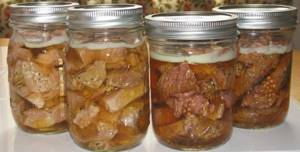
Beef is considered more acceptable for those losing weight and not wanting to gain weight than pork or lamb. This also applies to stewed meat. Let's figure out what the calorie content of buckwheat with stew is per 100 grams using simple recipes.
Stew for losing weight - evil or good?
Good afternoon. I'm Vitaly Sorokin and today we'll find out whether you can eat stewed meat on a diet. It would seem that the answer is obvious - such unhealthy eating should be excluded. But the search for an answer to this question yielded slightly unexpected results. So, without much preamble, let’s get down to business.
Or rather, to the stove. We will prepare stew for those losing weight. Let's take a jar, mix its contents with buckwheat (we'll boil some potatoes if you want) - and, voila, you've got a tasty, nutritious and terribly high-calorie dish! What are you saying - are you on a diet and you can’t do this? Who said it’s not possible and, most importantly, why not? Let's look at the question.
Recipe 1
To prepare buckwheat with stew you will need the following ingredients:
- 200 g buckwheat;
- salt to taste;
- 1 can of beef stew;
- pepper to taste;
- carrots - 1 pc.;
- garlic - 1 clove;
- onion - 1 pc.
Cooking method:
Open the stew and be sure to remove the fat from it. If you do not want to gain weight, move it as far away from your eyes as possible, and if you are not overweight, you can use this fat for frying vegetables. Peel the vegetables, chop them or, on the contrary, cut them into larger pieces. Add a small amount of oil or water, add vegetables and, stirring continuously, bring to readiness. Add meat, pepper and salt in the amount required for you. There are two ways to prepare cereal for a dish:
- Rinse thoroughly and place in a frying pan (cauldron), fill with water, and cook like pilaf.
- Steam or boil the buckwheat in advance, add to the meat, and cook until cooked for 5 minutes.
Weighing all the pros and cons
So what have we come to, my dear readers? It seems to me that when losing weight, stew is not needed. (Or am I wrong? Share your opinion in the comments). But if you still cannot do without it, then it is best to buy products from trusted manufacturers and carefully read the label.
If it’s not easy for you to figure out how to choose the right product in the store (we’re not just talking about stewed meat), then the “Big Guide to the Right Products” can help here - a real compass in the great variety of products that are presented in our supermarkets today.
This is not just a book - it is a colorfully illustrated publication, with numerous cooking tips and recipes - a real treat for everyone who wants to eat tasty and healthy.
Recipe 2
This cooking option is less suitable for maintaining weight due to pork, which, as is already known, has a higher calorie content than beef. You can also prepare this dish in a frying pan or cauldron.
We will need:
- buckwheat 200 grams;
- 1 can of pork stew;
- onion - 1 piece;
- mushrooms - 150 grams;
- tomato paste - 1 tablespoon.
Cooking method:
Rinse the buckwheat thoroughly until the water runs clear. In a frying pan, fry mushrooms with finely chopped onions, add tomato paste at the end. At the same time add the stew and buckwheat, mix well. Cook over low heat, gradually adding water, until the buckwheat is cooked.
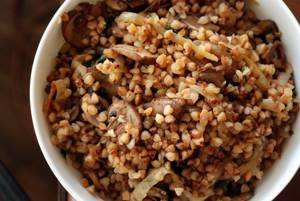
The calorie content of buckwheat with pork stew is about 220 kcal. Quite high, since in addition to fatty meat, there are also mushrooms, which tend to absorb large amounts of oil.
How to lose weight on buckwheat
If you decide to try the buckwheat diet, do not forget to follow the rules on which the result of losing weight depends. Do not add spices and sauces to the menu. Drink up to two liters of clean water a day. If, in the process of losing extra pounds, you begin to feel weak and dizzy, the diet should be stopped. Don't forget to take an additional vitamin complex. Although buckwheat is a rich source of microelements, a mono-diet is not the best way to lose weight.
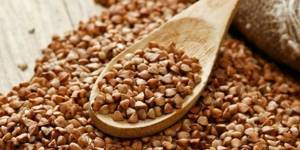
Recipe 3
And this is the most simple recipe that will allow you to prepare an equally tasty, but rather low-calorie lunch. Here's what it needs:
- buckwheat - 200 g;
- onion - 1 pc.;
- stew - 1 can;
- salt, pepper - to taste;
- water - as needed.
Cooking method:
The cereal must be thoroughly rinsed until the water becomes transparent, and let stand for about half an hour (if you don’t have time, you can do without it). In a cauldron, knead the stew, add onions, which are not fried in this recipe, however, if such a desire arises, then why not. But remember: this will increase the calorie content of the dish, and there is no escape from it. Stir the onion and meat for five minutes, after which buckwheat is added. Add salt and pepper, stir thoroughly, cook over low heat for 25 minutes, add water if necessary. In this recipe, buckwheat will be completely cooked in the juice of the stew, soaked in it and acquiring a rich taste. The calorie content of buckwheat with stew per 100 grams is 130 kcal.
How many calories are in buckwheat porridge per 100 grams?
Buckwheat was brought to us from Greece, which is why it got its name – buckwheat. Buckwheat is produced from the cereal crop - buckwheat, by cleaning the grain from the hard shell. Buckwheat stores well, does not go rancid, and is widely used for preparing various dishes.
After cleaning, the grain can be steamed, roasted or crushed. But vitamins are best preserved in unfried whole grains - buckwheat.
Despite its high calorie content, buckwheat is a dietary product due to its balanced combination of nutrients and fiber.
Table: calorie content of dry buckwheat, 100 grams of product contains:
| How much fat? | 2.6 g |
| How many carbohydrates? | 68 g |
| How many proteins? | 12.6 g |
| Total calories | 345 kcal |
Carbohydrates in cereals take longer to digest, which is why they are called “slow”; they create a feeling of fullness for a long time, which promotes weight loss. Many dishes are prepared from buckwheat: with milk, with mushrooms, with meat, with stew, with onions and vegetables - it goes well with a variety of products.
With milk
| Name | Quantity | fats | carbohydrates | squirrels | Total kcal |
| Buckwheat (half a glass) | 110 gr | 1.3 | 34 | 6.3 | 173 |
| Milk (1 glass) | 240 ml | 10.36 | 0 | 7.68 | 124 |
| Water (1 glass) | 240 ml | 0 | 0 | 0 | 0 |
| Sugar (1 tablespoon) | 30 gr | 0 | 29.9 | 0 | 119 |
| Total calories per 2 servings/270 grams | 550 | 105 | 255 | 56 | 416 |
Traditionally, porridge is cooked in milk; this also applies to buckwheat; 100 grams of buckwheat with milk contains only 76 kcal.
To improve the taste, buckwheat porridge with milk can be seasoned with butter, then the taste will become even more delicate. The calorie content of boiled buckwheat porridge with milk, butter and sugar increases by about 50 kcal/100 grams.
With stew
| Name | Quantity | fats | carbohydrates | squirrels | Total kcal |
| Buckwheat (2.5 cups) | 500 gr | 13 | 340 | 63 | 1729 |
| Stew (1 can) | 400 gr | 69.6 | 0 | 56.4 | 852 |
| Water (5 glasses) | 1.2 l | 0 | 0 | 0 | 0 |
| Onion (2 pcs) | 200 gr | 0 | 20.8 | 2.8 | 96 |
| Carrots (1 piece) | 100 gr | 0.1 | 6.9 | 1.3 | 35 |
| Volume. pasta (3 tablespoons) | 100 gr | 1.5 | 16.7 | 5.6 | 104 |
| Butter (3 tablespoons) | 100 gr | 82.5 | 0.8 | 0.5 | 744 |
| Total calories in 9 servings/250 grams | 2350 gr | 1500 | 1540 | 519 | 3560 |
100 grams of buckwheat with stew contains 151 kcal.
Stewed dishes are universal, easy to prepare and valued for their high taste.
With vegetables
| Name | Quantity | fats | carbohydrates | squirrels | Total kcal |
| Buckwheat (1 cup) | 220 gr | 5.72 | 150 | 27.7 | 760 |
| Water (2 glasses) | 480 ml | 0 | 0 | 0 | 0 |
| Carrots (1 piece) | 100 gr | 0.1 | 6.9 | 1.3 | 35 |
| Bow (1 piece) | 100 gr | 0 | 10.4 | 1.40 | 47.2 |
| Tomato (1 piece) | 100 gr | 0.2 | 4.2 | 0.6 | 21 |
| Sweet pepper (1 piece) | 100 gr | 0 | 5.3 | 1.3 | 26.4 |
| Sunflower oil (3 tablespoons) | 100 ml | 99.86 | 0 | 0 | 898.7 |
| Total calories in 4 servings of 260 grams | 1100 gr | 952 | 707 | 129 | 1789 |
Juicy buckwheat with bright, healthy and low-calorie vegetables is a wonderful alternative to regular porridge, calorie content is only 162 kcal per 100 grams.
If you need to reduce calories, try using less oil.
- We recommend reading: cleansing the body with buckwheat and kefir
With meat
| Name | Quantity | fats | carbohydrates | squirrels | Total kcal |
| Buckwheat (2.5 cups) | 500 gr | 13 | 340 | 63 | 1729 |
| Fillet of beef | 500 gr | 62 | 0 | 94.5 | 936 |
| Bow (1 piece) | 100 gr | 0 | 10.4 | 1.40 | 47.2 |
| Carrots (1 piece) | 100 gr | 0.1 | 6.9 | 1.3 | 35 |
| Tomato. pasta (3 tbsp.) | 100 gr | 1.5 | 16.7 | 5.6 | 104 |
| Water (6 glasses) | 1.4 l | 0 | 0 | 0 | 0 |
| Vegetable oil (2 tablespoons) | 60 ml | 59.91 | 0 | 0 | 539 |
| Total calories per 10 servings/250 grams | 2500 gr | 1228 | 1496 | 663 | 3390 |
Buckwheat with meat turns out especially tasty if you bake it in pots; the energy value is only 135 kcal per 100 grams.
With mushrooms
| Name | Quantity | fats | carbohydrates | squirrels | Total kcal |
| Buckwheat (glass) | 220 gr | 5.72 | 150 | 27.7 | 760 |
| Champignon mushrooms) | 300 gr | 3 | 0.3 | 12.9 | 80 |
| Onion (2 pcs) | 200 gr | 0 | 20.8 | 2.8 | 96 |
| Vegetable oil (1 table spoon) | 30 gr | 29.96 | 0 | 0 | 270 |
| Water (2 glasses) | 480 ml | 0 | 0 | 0 | 0 |
| Total calories per 5 servings/220 grams | 1100 gr | 348 | 684 | 174 | 1206 |
Buckwheat porridge with mushrooms contains - a traditional Russian dish can be prepared with any mushrooms: dried, frozen, fresh.
The energy value of buckwheat with champignons is about 109 kilocalories per 100 grams.
With onion
| Name | Quantity | fats | carbohydrates | squirrels | Total kcal |
| Buckwheat (glass) | 220 gr | 5.72 | 150 | 27.7 | 760 |
| Bow (1 piece) | 100 gr | 0 | 10.4 | 1.40 | 48 |
| Oil drain. (1 tbsp) | 30 gr | 24.75 | 0.24 | 0.15 | 225 |
| Water (2 glasses) | 480 ml | 0 | 0 | 0 | 0 |
| Total calories per 3 servings/240 grams | 730 | 274 | 642 | 117 | 1033 |
Tender, crumbly buckwheat with onions and dietary gravy will perfectly satisfy hunger and is suitable for those who want to lose weight, because the calorie content per 100 grams is only 141 kcal.
With Chiken
| Name | Quantity | fats | carbohydrates | squirrels | Total kcal |
| Buckwheat (glass) | 220 gr | 5.72 | 150 | 27.7 | 760 |
| Chicken carcass (1 piece) | 1.2 kg | 154 | 0 | 176 | 2090 |
| Carrots (1 piece) | 100 gr | 0.1 | 6.9 | 1.3 | 35 |
| Bow (1 piece) | 100 gr | 0 | 10.4 | 1.40 | 47.2 |
| Sunflower oil (2 tablespoons) | 60 ml | 59.91 | 0 | 0 | 539 |
| Mayonnaise (1 tbsp.) | 30 gr | 20.1 | 0.78 | 0.93 | 188 |
| Water (2 cups) | 480 ml | 0 | 0 | 0 | 0 |
| Total calories per 7 servings/220 grams | 1600 gr | 2160 | 672 | 828 | 3660 |
Chicken stuffed with buckwheat is an appetizing, aromatic and very tasty dish that is perfect for a holiday table.
The energy value of buckwheat with chicken is 228 kcal/100 grams.
The fairly high calorie content of the dish can be reduced if you do not coat the chicken with mayonnaise and stew the vegetables without vegetable oil; the calorie content will decrease by about 50 kcal/100 grams.
beneficial elements in buckwheat
Table: content of microelements and vitamins per 100 grams of dry buckwheat
| Name | Daily requirement % | |
| Co (cobalt) | 3.1 mcg | 0.31 |
| PP (niacin) | 4.19 mg | 17 |
| K (potassium) | 380 mg | 19 |
| Ca (calcium) | 20 mg | 2 |
| Mg (magnesium) | 200 mg | 57 |
| B9 (folic acid) | 32 mcg | 3.2 |
| B1 (thiamine) | 0.43 mg | 29 |
| B6 (pyridoxine) | 0.4 mg | 20 |
| Fe (iron) | 6.6 mg | 44 |
| Cu (copper) | 0.64 mg | 43 |
| B2 (riboflavin) | 0.2 mg | 12 |
Buckwheat also contains manganese, chromium, silicon and zinc.
THESE ARTICLES WILL HELP YOU LOSE WEIGHT
Your review of the article: ( 987 4.50 out of 5) Loading…
Let's sum it up
You can come to the conclusion that the calorie content of buckwheat with beef stew is much less than with pork, but which one to use is up to you.
Buckwheat is useful for its composition for the human body, even in combination with other products; it is also suitable for weight loss with all its parameters. And if you combine it with a fairly high-calorie product - stew, you are unlikely to gain weight.

However, it is worth understanding that by using various seasonings and flavoring additives, we increase the calorie content of any, even the most dietary dish. Therefore, if it is still difficult for you to eat cereal in its pure form, you can, of course, cook it, for example, with meat or stew, but in this case, try to add a minimum of spices.
Buckwheat is not only healthy, but can also be tasty if you show desire and imagination.
How to store for a long time
What is canned meat, as in our case? That's right - products that are prepared in such a way that they can be stored for a long time and do not require any special conditions for this.
What is being done for this? They are processed in a special way, using heat treatment, adding salt and other preservatives.
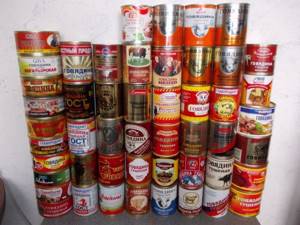
What does it mean? Something like this:
- a very high cooking temperature ultimately destroys almost all the vitamins present in meat (although there are practically none there)
- The fiber and water content in canned foods is significantly lower than in fresh foods. Because of this, they are less filling and have a higher calorie content.
- To preserve the meat better, it is filled with fat. Its content in a finished beef dish can reach 17-20%, in pork – 35%.
- Along with the product indicated on the label, numerous chemicals often end up in the jar: dyes, flavor enhancers, stabilizers.
Liver cells are responsible for their neutralization, but if they fail, then “preservation” of harmful aliens from the outside occurs due to the creation of fat cells from them. It turns out to be very difficult to break down such a “gift” - doctors believe that one such cell can store a “reserve of chemicals” for 8 years.

If we go on a diet, the active process of breaking down adipose tissue begins. From there, toxins “hidden” there enter the bloodstream, and as a result, we may not feel the best.
What follows from all of the above? Should I throw the purchased can in the trash or not spend money on buying it at all? Don't rush, let's take a careful look at the label first.
What does the label hide?
It should be glued securely, and not with a couple of drops of glue, and the manufacturer should be indicated on it. Specialists from the public organization Roskontrol believe that it is desirable for this to be a plant located in traditional “meat” areas, where livestock farming is developed - for example, Buryatia, Orenburg region.
In addition, the label usually contains very interesting information. Namely:
- Canned food comes in natural and snack varieties. Natural ones are marked “Beef” or “Pork”, and all sorts of “Stews” are from the desire of manufacturers to pass off something from the field of their invention as meat.
- Natural ones contain only meat, salt, fat and spices. The pieces of meat are approximately 30 grams in size and can be easily separated with a fork.
- In snack bars there is butter, sugar, and much more. Meat is often a single monolith, which indicates that the ingredients were mixed all at once, and not separately, as required by the technology for preparing such canned food.

- Fat - without this there is no stew. 100 grams of pork or beef fat contains a huge number of calories - 897. And if canned fish can be bought straight away, this trick will not work with meat - the fat will always be there. You should immediately get rid of it (just skim off this wealth with a spoon) if you don’t need the extra calories.
- Soybeans – used to reduce costs.
- Semolina - in addition to the fact that it should not be in a jar, it also has a high glycemic index, which is harmful for those losing weight.
- Carrageenan is used as a thickener to create the illusion for the buyer that “there is nothing gurgling in the can, which means there is a lot of meat in there.” It is practically not absorbed by the body, remains in the intestines and can contribute to indigestion.
Let's look under the lid
It is necessary to distinguish between a product prepared in accordance with GOST and in accordance with TU. According to the rules, specifications must also guarantee the quality of your purchase. But in reality, only the manufacturers know what they added to their jar, guided by the specifications (technical conditions) they invented.
In such jars, if you look under the lid and look carefully, you can find carefully hidden there:
- offal and compressed frozen meat
- ground veins, skins, cartilage, clots of blood vessels
- soy meat and other substitutes
- flavorings - create the illusion that you are eating natural meat with the same natural spices.
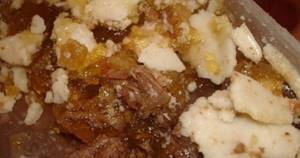
But in such canned food there may be no meat at all, or its content will not exceed 20% of the total weight.
Often, this is not indicated on the label at all or with a distortion of the truth. This is actually called deceiving the buyer. But, since the facts exist (based on the results of inspections by the same Roskontrol), it is worth mentioning this.
The fact is that data on the content of protein, salt, mass fraction of fat - all this often does not correspond to reality. Therefore, it can be difficult for a buyer who is looking for a more or less normal stew to navigate.
